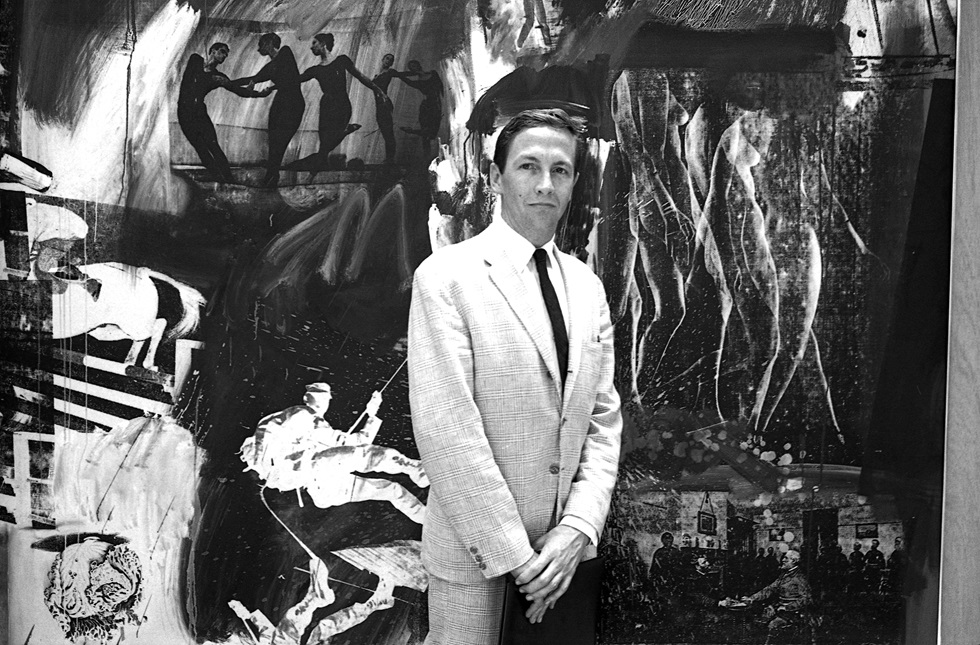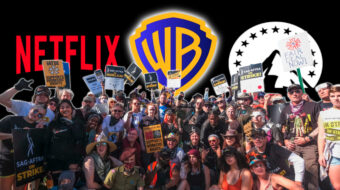
The new documentary film Taking Venice by director Amei Wallach, a Zeitgeist Films release in association with Kino Lorber, takes viewers on a journey not just to the famous canal city in Italy, but through the intricate maze of influence, commerce, ideology, and politics that led to the 1964 jury selection of Robert Rauschenberg as the first American to win the grand prize at the world’s most prestigious art exhibition, the Olympics of art, the Venice Biennale.
The film is structured as a suspense story, though we know the conclusion before we even set foot in the theater. The musical score helps to keep viewers on the edge of their seats.
As has been copiously documented, one of the “soft power” weapons the U.S. deployed during the Cold War was culture. The American position was that under conditions of “freedom,” the individual artist was able to create whatever they wanted, whereas the stultifying Communist regimes allowed only dull, uninspired official art. At least, such was the image of the U.S. that Americans wanted to project to the world, which helps explain why the U.S. State Department was so eager to send artists such as Louis Armstrong and Duke Ellington on tours abroad, to combat the perception of the U.S. as a racist country.

The film features interviews with Alice Denney, now over 100 years old, who was a Washington insider—her husband had a prominent CIA position—and a friend of the Kennedys. She prevailed upon the United States Information Agency (USIA) to involve itself for the first time in the 1964 Venice Biennale with the goal of getting an American artist selected for the grand prize. Curator Alan Solomon had shown Robert Rauschenberg (1925-2008) in a major exhibition at the Jewish Museum that established the experimental pop-culture artist as one of the trailblazing leaders in postwar American art. His “combines” fused the disciplines of painting and sculpture with found objects and imagery derived from advertising, newspapers, and other expressions of pop culture in fresh ways that had not been seen in quite the same way before, though the Dadaists of the post-World War I also did similar work. Solomon was soon working with world-renowned art dealer Leo Castelli to mastermind Rauschenberg’s success in Venice.
Although an American Pavilion existed at the Biennale, and was used to display others of that year’s delegation of artists, the best and biggest work was shown not on the grounds of the Biennale itself but in the recently decommissioned and now empty U.S. Consulate building in Venice, a boat ride away. Part of the suspense in the film entails this departure from the Biennale rules: No one had ever won based on a body of work shown outside the Biennale compound. In the end, fearing the rules might prevent an American win, a temporary annex was built onto the American Pavilion to show Rauschenberg’s work, thus officially overcoming the objection. “We didn’t cheat,” recalls Alice Denney, “we had a goal!”
How to transport Rauschenberg’s monumental work to Venice is another “thriller” aspect to the story. That involved recruiting U.S. military planes normally used for flying Army tanks around the world to haul wooden crates filled with quirky modern art. The “influence” to make this happen was apparent to the world, not to mention the involvement of the U.S. government in approving the Consulate locale. Critics and large swaths of the international art-loving public harbored deep suspicion about the American power play, some of it in plain sight, such as lavish parties with free-flowing booze, and obviously much more, possibly including bribes, behind the scenes. “Foul play!” shouted the headlines. Even Rauschenberg himself, who parades through the film as a kind of innocent abroad, is allowed his moments of doubt as to the American nationalism his work is purported to serve.
One of the most persuasive factors in swaying the Biennale’s jurors over to the American side was the quickly arranged appearance, the night before the jurors’ final vote, of the Merce Cunningham Dance Company at the Teatro La Fenice in Venice, one of the most beautiful and highly respected opera houses in the world. Cunningham collaborated with the modernist composer John Cage, and in fact, in an earlier phase of Rauschenberg’s career, he had worked on stage sets and costumes with Cunningham and Cage at Black Mountain College. So now, aside from the art on display at and adjacent to the Biennale, the jurors, and the public, could see how the boldly independent spirit of American art also flourished in dance, scenic design, and music—all of which, not so incidentally, Rauschenberg had also contributed to. The sales pitch was overwhelming.
Commendably, Taking Venice takes full account of the multi-dimensionality of this tale, not neglecting to point out the rank commercialism of the art market emerging in the 1960s with artists such as Andy Warhol, Roy Lichtenstein, George Segal, Jim Dine, Claes Oldenburg, and Jasper Johns. In a flush economic environment, art acquisition became one of the most visible markers of status—not for the first time, of course, but with astronomical dollar figures that boggled the imagination. Dealers such as Castelli made fortunes for themselves and for some of the artists in their stables by shrewd manipulation of the press, critics, academia, and museum and gallery curators. What was new was the ascendance of American art: New York had now surged way past Paris as the world’s creative center for art.
In its admirable commitment to let all the secrets out, and allow viewers to assess the outcome of the story for themselves, the film does not shy away from affirming that for a period of at least a decade, Rauschenberg and Johns were romantic partners, as well as each other’s most passionate critics and mentors.
It’s unavoidable to see this expansionist grab on the part of the Americans as only one aspect of the U.S. hegemonic aim, shamelessly exploiting the world’s sorrow at the assassination of the world’s beloved U.S. President Kennedy less than a year before.
Nor does the film shy away from documenting how, in short order, in the years following the 1964 Biennale, the optimistic, confident American star began to dim considerably as the wars in Indochina grew ever more ferocious, as the racial crisis at home intensified, as the assassination of public figures became almost routine, and as a later president, the corrupt Richard Nixon, was forced to resign.
Covering a lot of ground, Taking Venice concludes in 2022 with Simone Leigh, the first Black woman to represent the U.S. at the Biennale.
In an iconic statement that the Robert Rauschenberg Foundation features on its website, the artist says, “Artists always have been the first to rally around any national or international problem, acting as a conscience.” In the years following the Biennale, he went on to address topics such as war, racism, apartheid, cultural exchanges with other countries, including socialist ones, and other humanitarian causes, all the while expanding his interests in technical advancement and allying his art with performance, choreography, music, and the stage. Fun fact: Rauschenberg was invited back to the Biennale again, in 1990, to exhibit at the Soviet Pavilion!
Taking Venice should rate high on any conscious moviegoer’s list. It’s savvy, honest, absorbing, well-edited, and revealing. The 98-minute documentary was released on May 17 and is showing in theaters. The trailer can be viewed here.
We hope you appreciated this article. At People’s World, we believe news and information should be free and accessible to all, but we need your help. Our journalism is free of corporate influence and paywalls because we are totally reader-supported. Only you, our readers and supporters, make this possible. If you enjoy reading People’s World and the stories we bring you, please support our work by donating or becoming a monthly sustainer today. Thank you!










